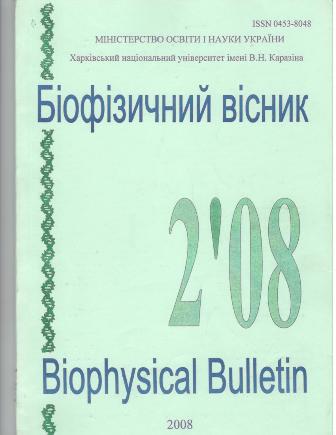Effect of aconitine-containing agent BC1 upon electrokinetic characteristics of tumor cells
Abstract
Earlier it has been shown, that aconitine-containing agent BC1 in noncytotoxic concentration is capable to cause inversion of a surface charge of endothelial cells that can result in inhibition of tumor vascularization and tumor growth. In vivo BC1 does not show anticancer action against Lewis lung carcinoma (LLC) while it is highly effective against its low-metastatic counterpart LLC/R9. Different anticancer efficacy of BC1 against LLC and LLC/R9 can be related to the different sensitivity of tumor cells. As voltage-gated sodium channels are the basic molecular target of aconitine alkaloid action, the purpose of the work was the comparative study of the influence of BC1 on electrokinetic characteristics of LLC and LLC/R9 cells as the possible mechanism of its anticancer action. LLC and LLC/R9 cells were incubated during 48 hours in a complete culture medium containing various concentrations of BC1, and linear speed of tumor cell movement in a constant electric field with an intensity of 20 V/sm in 0,1 M phosphatic buffer at pH 7,0 and t=27°C was measured. It was found, that 100% of tumor cells (independently on BC1 concentrations) showed electrophoretic mobility and had a negative surface charge. In the absence of BC1 ζ- potential distribution of LLC/R9 cells was characterized by shift (in comparison with LLC cells) towards lower values. BC1 caused a reduction of C-potential and the absolute value of the surface charge density of LLC/R9 cells of about 20-30% and did not influence the surface charge of LLC cells. Since the decrease in surface charge can cause tumor cell death or redifferentiation, the anticancer activity of BC1 against LLC/R9 can be associated with BC1-induced changes in the surface charge of tumor cells.
Downloads
References
2. Gutser U., Friese J., Heubach J. et al. // Naunyn Schmiedebergs Arch. Pharmacol. 1998. V.357. P.39-48.
3. Wang S.Y., Wang G.K. // Cell. Signal. 2003. V.15. P.151-159.
4. Garmanchouk L.V., Pyaskovskaya O.N., Yanish Yu. et al. // Exp. Oncol. 2005. V.27. P.262–266.
5. Fraser S.P., Diss J.K.J., Mycielska M.E. et al. // Breast Cancer Res. Treat. 2002. V.76. S142.
6. Grimes J.A., Fraser S.P., Stephens G.J. et al. // FEBS Lett. 1995. V.369. P.290-294.
7. Diss J.K.J., Fraser S.P., Djamgoz M.B.A. // Eur. Biophys. J. 2004. V.33. P.180-193.
8. Gumcovski F., Kaminska G., Kaminski M. et al. // Bloоd Vessels. 1987. V.24. P.11-23.
9. Mosmann T. // J. Immunol. Methods. 1983. V.65. P.55-63.
10. Nicoletti I., Migliorati G., Pagliacci M.C. et al. // J. Immunol. Methods. 1991. V.139. P.271-280.
11. Олішевський С.В., Яніш Ю.В., Козак В.В., Шляховенко В.О. // Доповіді НАНУ. 2005. № 11. С.178-182.
12. Иенсен Г.Л. // Иммунологические методы, под ред. Х. Фримеля. М. Мир, 1979. С.195–208.
13. Захарченко В.Н. Коллоидная химия. М. Высшая школа, 1974. 216с.
14. Li X., Kolega J. // J. Vasc. Res. 2002. V.39. P.391–404.
15. Carter H.B., Coffey D.S. // J. Urol. 1988. V.140. P.173-175.
16. Carter H.B., Partin A.W., Coffey D.S. // J. Urol. 1989. V.142. P.1338-1341.
17. Dobrzyńska I., Szachowicz-Petelska B. et al. // Mol. Cell. Biochem. 2005. V.276. P.113-119.
18. Márquez M., Nilsson S., Lennartsson L. et al. // Anticancer Research. 2004. V.24. P.1347-1351.
19. Okuyama S., Sano M., Awano T. et al. // Tohoku J. Exp. Med. 1984. V.142. P.347-348.
20. Sun Y.X., Zheng Q.S., Li G. et al. // Biomed. Environ. Sci. 2006. V.19. P.385-391.
Authors who publish with this journal agree to the following terms:
- Authors retain copyright and grant the journal right of first publication with the work simultaneously licensed under a Creative Commons Attribution License that allows others to share the work with an acknowledgement of the work's authorship and initial publication in this journal.
- Authors are able to enter into separate, additional contractual arrangements for the non-exclusive distribution of the journal's published version of the work (e.g., post it to an institutional repository or publish it in a book), with an acknowledgement of its initial publication in this journal.
- Authors are permitted and encouraged to post their work online (e.g., in institutional repositories or on their website) prior to and during the submission process, as it can lead to productive exchanges, as well as earlier and greater citation of published work (See The Effect of Open Access).





